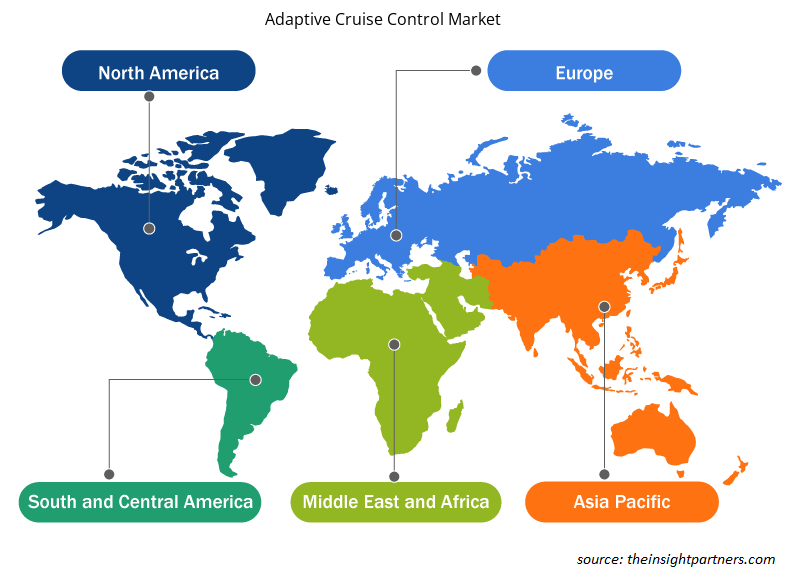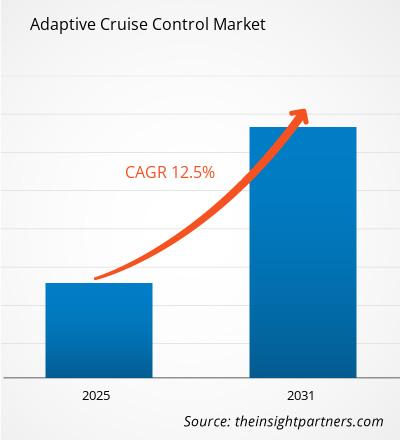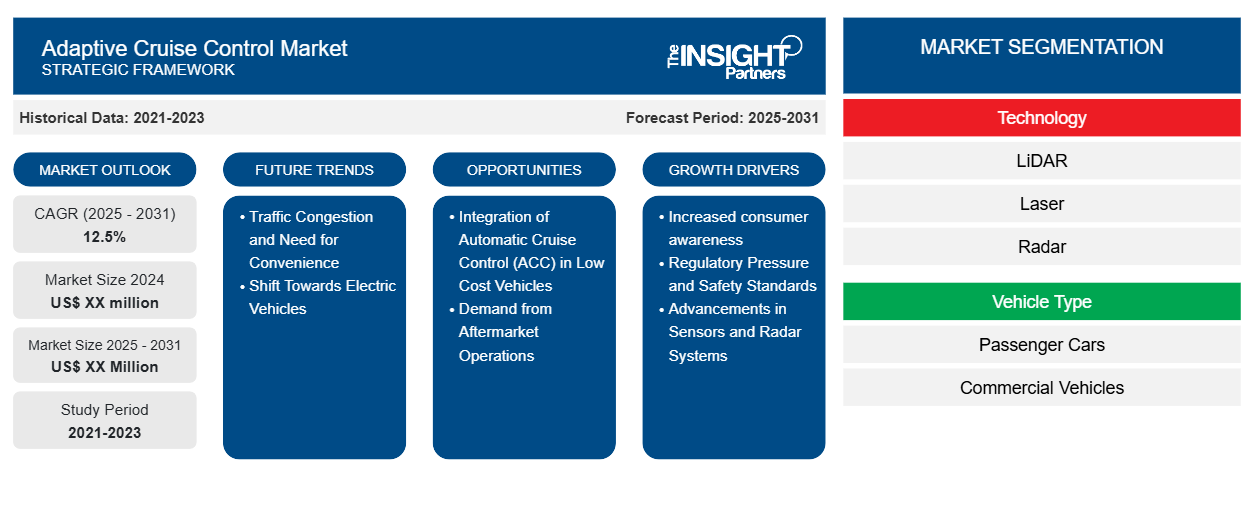من المتوقع أن يسجل سوق التحكم التكيفي في ثبات السرعة معدل نمو سنوي مركب بنسبة 12.5٪ من عام 2023 إلى عام 2031، مع توسع حجم السوق من XX مليون دولار أمريكي في عام 2023 إلى XX مليون دولار أمريكي بحلول عام 2031.
تم تقسيم التقرير حسب التكنولوجيا (الليدار والليزر والرادار) ونوع المركبة (سيارات الركاب والمركبات التجارية)، كما تم تقسيم التحليل العالمي بشكل أكبر على المستوى الإقليمي والدول الرئيسية. يقدم التقرير القيمة بالدولار الأمريكي للتحليل والقطاعات المذكورة أعلاه.
غرض التقرير
يهدف تقرير سوق التحكم التكيفي في السرعة الصادر عن The Insight Partners إلى وصف المشهد الحالي والنمو المستقبلي وأهم العوامل الدافعة والتحديات والفرص. وسيوفر هذا رؤى لمختلف أصحاب المصلحة في الأعمال التجارية، مثل:
- مزودي/مصنعي التكنولوجيا: لفهم ديناميكيات السوق المتطورة ومعرفة فرص النمو المحتملة، وتمكينهم من اتخاذ قرارات استراتيجية مستنيرة.
- المستثمرون: إجراء تحليل شامل للاتجاهات فيما يتعلق بمعدل نمو السوق، وتوقعات السوق المالية، والفرص المتاحة عبر سلسلة القيمة.
- الهيئات التنظيمية: لتنظيم السياسات ومراقبة الأنشطة في السوق بهدف تقليل الانتهاكات والحفاظ على ثقة المستثمرين ودعم سلامة السوق واستقرارها.
تجزئة سوق نظام تثبيت السرعة التكيفي
تكنولوجيا
- ليدار
- الليزر
- رادار
نوع المركبة
- سيارات الركاب
- المركبات التجارية
قم بتخصيص هذا التقرير ليناسب متطلباتك
ستحصل على تخصيص لأي تقرير - مجانًا - بما في ذلك أجزاء من هذا التقرير، أو تحليل على مستوى الدولة، وحزمة بيانات Excel، بالإضافة إلى الاستفادة من العروض والخصومات الرائعة للشركات الناشئة والجامعات
- احصل على أهم اتجاهات السوق الرئيسية لهذا التقرير.ستتضمن هذه العينة المجانية تحليلاً للبيانات، بدءًا من اتجاهات السوق وحتى التقديرات والتوقعات.
عوامل نمو سوق نظام تثبيت السرعة التكيفي
- زيادة وعي المستهلك: مع تزايد وعي المستهلكين بخصائص السلامة في المركبات، يتزايد أيضًا الطلب على تقنيات السلامة المتطورة مثل أنظمة التحكم التكيفي في ثبات السرعة. ويحتاج المصنعون إلى تجهيز مركباتهم بهذه الأنظمة لتلبية توقعات المستهلكين وتحسين تصنيف السلامة.
- الضغوط التنظيمية ومعايير السلامة: تفرض الحكومات ومنظمات السلامة لوائح ومعايير سلامة صارمة على المركبات. وتدفع البيئة التنظيمية الصارمة شركات صناعة السيارات إلى تبني تقنيات التحكم التكيفي في السرعة لتلبية معايير السلامة المطلوبة، وهو ما يدفع نمو السوق. وتنفذ الحكومات في جميع أنحاء العالم معايير سلامة أكثر صرامة للمركبات، مما يجبر شركات تصنيع السيارات على تزويد المركبات بميزات أمان متقدمة مثل نظام تثبيت السرعة التكيفي. وتفعل الحكومات هذا للحد من الوفيات الناجمة عن حوادث الطرق وتحسين السلامة العامة. وفي الولايات المتحدة وأجزاء أخرى من أوروبا، تجبر الحكومات الآن شركات تصنيع السيارات على تضمين تقنيات أنظمة مساعدة السائق المتقدمة، مثل نظام تثبيت السرعة التكيفي، في الموديلات الجديدة. على سبيل المثال، اشترط الاتحاد الأوروبي أن تتضمن السيارات الجديدة ميزات مثل الكبح التلقائي في حالات الطوارئ، والذي يستخدم غالبًا مع نظام تثبيت السرعة التكيفي.
- التطورات في أجهزة الاستشعار وأنظمة الرادار: تستخدم أنظمة التحكم التكيفي في السرعة مجموعة متنوعة من أجهزة الاستشعار والرادار وتقنيات الكاميرات للكشف عن المسافة والسرعة وحركة المركبات التي أمامك. وقد أدت التطورات الأخيرة في تقنيات الاستشعار هذه إلى تحسين أداء أنظمة التحكم التكيفي في السرعة وموثوقيتها وقدرتها على تحمل التكاليف بشكل كبير. وقد تقدمت تقنيات الرادار والليدار بحيث يمكن لأنظمة التحكم التكيفي في السرعة اكتشاف الأشياء بدقة أكبر على مسافات أعلى، حتى في الظروف الممطرة أو الضبابية والقيادة الليلية. ومع انخفاض تكاليف تقنية أجهزة الاستشعار والرادار، يتم تركيب أنظمة التحكم التكيفي في السرعة على نطاقات أوسع من طرازات المركبات من قبل شركات تصنيع السيارات، بما في ذلك الطرازات المتوسطة والأولية.
الاتجاهات المستقبلية لسوق نظام تثبيت السرعة التكيفي
- الازدحام المروري والحاجة إلى الراحة: إن التوسع الحضري المتزايد والازدحام المروري المتزايد على الطرق يدفعان الطلب على التقنيات التي تقلل من ضغوط القيادة، وخاصة في حركة المرور المتقطعة. يساعد نظام التحكم التكيفي في الثبات لأنه يتكيف تلقائيًا مع السرعة مع تدفق حركة المرور، مما يجعله مفيدًا جدًا لحركة المرور الكثيفة في المناطق الحضرية أو الطرق السريعة. إن الوقت المتزايد الذي يقضيه السائقون في حركة المرور، وخاصة أثناء التنقل، يشجع السائقين على البحث عن التقنيات التي تجعل القيادة أقل إرهاقًا. يمنح نظام التحكم التكيفي في الثبات ميزة توفير سرعة ثابتة ومسافة متابعة مناسبة، وبالتالي يتطلب التسارع والكبح بشكل أقل تكرارًا. تعد القدرة على السرعة المنخفضة أكثر شيوعًا في أنظمة التحكم التكيفي في الثبات لتمكينها من الأداء في ظل ظروف التوقف والانطلاق في حركة المرور. وهذا أمر جيد لأنه لا يجعل السائقين يبذلون الكثير من الجهد في حركة المرور الكثيفة حيث سيسيرون وفقًا للوتيرة فقط.
- التحول نحو المركبات الكهربائية: تساهم شعبية المركبات الكهربائية والهجينة، والتي عادة ما تلائم وصف ADAS، أيضًا في زيادة اعتماد ACC. تشتهر المركبات الكهربائية والهجينة بحمل أنظمة كهربائية وأجهزة استشعار أكثر تعقيدًا تكمل تمامًا الوظيفة التي يوفرها ACC. تحمل معظم المركبات الكهربائية والهجينة، وخاصة مصنعي المركبات الفاخرة، تثبيت ACC كمعيار في السيارة. سيؤدي هذا إلى دمج ACC في المركبات الكهربائية وسيدعم الاتجاه نحو أنظمة قيادة أكثر ذكاءً وتلقائية في سوق المركبات الكهربائية. يتم تسويق المركبات الكهربائية والهجينة في الغالب لميزاتها التكنولوجية العالية، ويُنظر إلى ACC كميزة متميزة تضيف قيمة إلى المركبة. تستمر مبيعات المركبات الكهربائية والهجينة في الارتفاع، مما يعني أن عددًا متزايدًا من المستهلكين سيبدأون في قبول ACC.
فرص سوق نظام تثبيت السرعة التكيفي
- دمج نظام تثبيت السرعة الأوتوماتيكي في المركبات منخفضة التكلفة: في البداية، كان نظام تثبيت السرعة الأوتوماتيكي يستخدم بشكل أساسي في المركبات الفاخرة. ومع ذلك، مع انخفاض تكلفة تقنيات الاستشعار، هناك مجال كبير لدمج نظام تثبيت السرعة الأوتوماتيكي في المركبات متوسطة الحجم والمركبات منخفضة التكلفة. يمكن للشركات التي تستهدف العملاء من ذوي الدخل المتوسط، وخاصة في الاقتصادات الناشئة، أن تقدم نظام تثبيت السرعة الأوتوماتيكي كميزات قياسية أو اختيارية في المركبات منخفضة التكلفة، وبالتالي زيادة انتشار نظام تثبيت السرعة الأوتوماتيكي في السوق بشكل كبير. في مناطق مثل آسيا والمحيط الهادئ وأمريكا اللاتينية وأفريقيا، حيث تنمو ملكية السيارات بسرعة، يمكن إطلاق المركبات المجهزة بنظام تثبيت السرعة الأوتوماتيكي بأسعار أقل نسبيًا، وبالتالي الوصول إلى شريحة سكانية أوسع.
- الطلب من عمليات ما بعد البيع: مع زيادة اعتماد ACC، تُعرض على الشركات الفرصة لتوريد أنظمة ACC ما بعد البيع التي يمكن تركيبها على المركبات القديمة حيث تقل مبيعات المركبات الجديدة. قد تقوم شركات ما بعد البيع بتصميم وبيع مجموعات التعديل من ACC للمركبات التي لا تحتوي على مثل هذه المرافق المثبتة. سيمنحهم هذا الفرصة للحصول على إيرادات للشركات التي تسوق للسائقين الذين يرغبون في تعزيز سلامة وراحة مركباتهم. الشراكة مع مقدمي الخدمات لإصلاح وصيانة المركبات لجعل تركيب ACC وترقيته متاحًا من شأنه أن يزيد من استخدام هذه التكنولوجيا بين المركبات القديمة.
رؤى إقليمية حول سوق نظام تثبيت السرعة التكيفي
لقد قام المحللون في Insight Partners بشرح الاتجاهات والعوامل الإقليمية المؤثرة على سوق نظام التحكم التكيفي في السرعة طوال فترة التوقعات بشكل شامل. يناقش هذا القسم أيضًا قطاعات سوق نظام التحكم التكيفي في السرعة والجغرافيا في جميع أنحاء أمريكا الشمالية وأوروبا ومنطقة آسيا والمحيط الهادئ والشرق الأوسط وأفريقيا وأمريكا الجنوبية والوسطى.

- احصل على البيانات الإقليمية المحددة لسوق نظام تثبيت السرعة التكيفي
نطاق تقرير سوق نظام تثبيت السرعة التكيفي
| سمة التقرير | تفاصيل |
|---|---|
| حجم السوق في عام 2023 | XX مليون دولار أمريكي |
| حجم السوق بحلول عام 2031 | XX مليون دولار أمريكي |
| معدل النمو السنوي المركب العالمي (2023 - 2031) | 12.5% |
| البيانات التاريخية | 2021-2022 |
| فترة التنبؤ | 2024-2031 |
| القطاعات المغطاة | حسب التكنولوجيا
|
| المناطق والدول المغطاة | أمريكا الشمالية
|
| قادة السوق وملفات تعريف الشركات الرئيسية |
|
كثافة اللاعبين في سوق نظام تثبيت السرعة التكيفي: فهم تأثيره على ديناميكيات الأعمال
يشهد سوق نظام التحكم التكيفي في السرعة نموًا سريعًا، مدفوعًا بالطلب المتزايد من المستخدم النهائي بسبب عوامل مثل تفضيلات المستهلكين المتطورة والتقدم التكنولوجي والوعي المتزايد بفوائد المنتج. ومع ارتفاع الطلب، تعمل الشركات على توسيع عروضها والابتكار لتلبية احتياجات المستهلكين والاستفادة من الاتجاهات الناشئة، مما يؤدي إلى زيادة نمو السوق.
تشير كثافة اللاعبين في السوق إلى توزيع الشركات أو المؤسسات العاملة في سوق أو صناعة معينة. وهي تشير إلى عدد المنافسين (اللاعبين في السوق) الموجودين في مساحة سوق معينة نسبة إلى حجمها أو قيمتها السوقية الإجمالية.
الشركات الرئيسية العاملة في سوق نظام تثبيت السرعة التكيفي هي:
- شركة أوتوليف
- شركة كونتيننتال ايه جي
- شركة دلفي للسيارات المحدودة
- شركة دينسو
- شركة فورد للسيارات
إخلاء المسؤولية : الشركات المذكورة أعلاه ليست مرتبة بأي ترتيب معين.

- احصل على نظرة عامة على أهم اللاعبين الرئيسيين في سوق نظام تثبيت السرعة التكيفي
نقاط البيع الرئيسية
- التغطية الشاملة: يغطي التقرير بشكل شامل تحليل المنتجات والخدمات والأنواع والمستخدمين النهائيين لسوق التحكم التكيفي في السرعة، مما يوفر صورة شاملة.
- تحليل الخبراء: تم تجميع التقرير على أساس الفهم العميق لخبراء الصناعة والمحللين.
- معلومات محدثة: يضمن التقرير أهمية الأعمال التجارية بسبب تغطيته للمعلومات الحديثة واتجاهات البيانات.
- خيارات التخصيص: يمكن تخصيص هذا التقرير لتلبية متطلبات العملاء المحددة وبما يتناسب مع استراتيجيات العمل بشكل مناسب.
وبالتالي، يمكن أن يساعد تقرير البحث حول سوق نظام التحكم التكيفي في السرعة في تمهيد الطريق لفك شفرة وفهم سيناريو الصناعة وآفاق النمو. ورغم وجود بعض المخاوف المشروعة، فإن الفوائد الإجمالية لهذا التقرير تميل إلى التفوق على العيوب.
- التحليل التاريخي (سنتان)، سنة الأساس، التوقعات (7 سنوات) مع معدل النمو السنوي المركب
- تحليل PEST و SWOT
- حجم السوق والقيمة / الحجم - عالمي، إقليمي، بلد
- الصناعة والمنافسة
- مجموعة بيانات إكسل
التقارير الحديثة
شهادات العملاء
سبب الشراء
- اتخاذ قرارات مدروسة
- فهم ديناميكيات السوق
- تحليل المنافسة
- رؤى العملاء
- توقعات السوق
- تخفيف المخاطر
- التخطيط الاستراتيجي
- مبررات الاستثمار
- تحديد الأسواق الناشئة
- تحسين استراتيجيات التسويق
- تعزيز الكفاءة التشغيلية
- مواكبة التوجهات التنظيمية





















 احصل على عينة مجانية ل - سوق مثبت السرعة التكيفي
احصل على عينة مجانية ل - سوق مثبت السرعة التكيفي